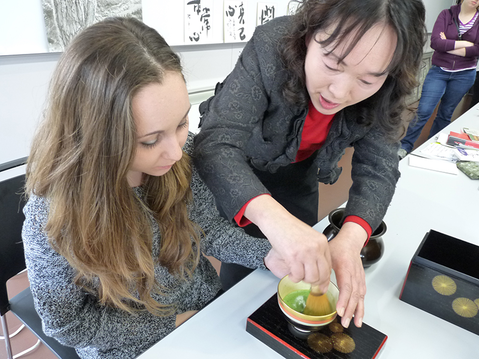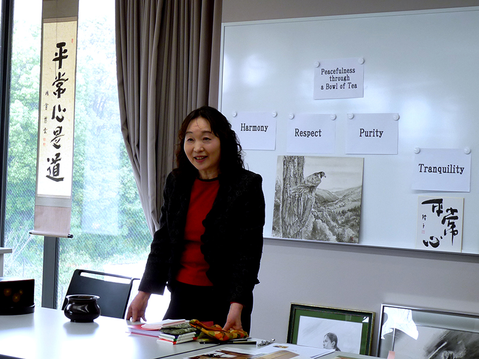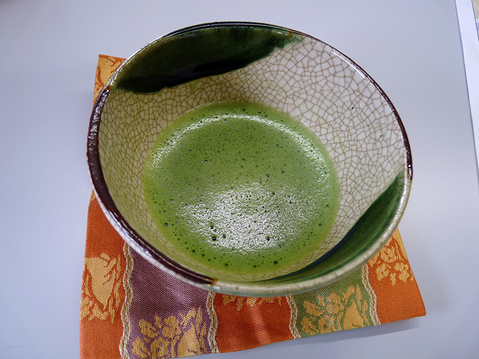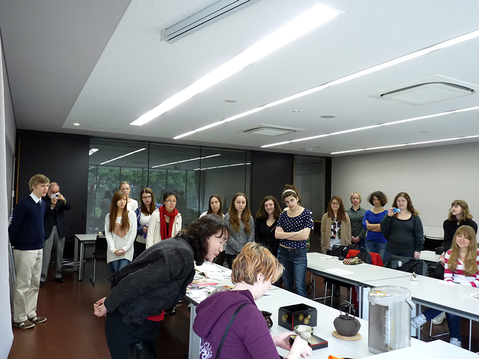Tea Ceremony Workshop
Mar 25, 2013 (Mon.)
On the first Saturday of Spring break, a workshop on the Tea Ceremony was conducted for the international students of Kansai Gaidai. The workshop was held by the tea practitioner and calligraphy artist Oki Reiko-san, who wished to introduce the students to the spiritual aspects of this uniquely Japanese performing art.
The workshop started out with an introductory explanation of the background of the practice of tea, as well as the message Oki-san wished to convey through this “one time, one meeting,” as the tea saying goes. The saying, as Oki-san also explained, means that each and every meeting between people is unique and cannot be redone in completely the same way. Therefore, in tea, each moment and each meeting with your host or your guests is cherished as a once-in-a-lifetime opportunity.
The message Oki-san wished to convey to the international students, was that peace between human beings and even countries, may be attained through the practice of the tea ceremony. She had made an ink painting for the occasion, with an eagle sitting in a tree, looking out over a mountain vista full of lush trees. “The bird represents all of you students,” Oki-san explained, “as you are about to enter society after your graduation.” To this she added, that respect and care for Nature and the environment, to keep the Earth a nice and beautiful place for future generations as well, was also a feeling she wished to convey with the painting, as well as the workshop.
After a brief demonstration of the “temae,” or tea procedure, using a box set of tea utensils for picnic-style tea, the students were invited one by one to try and whisk a bowl of tea themselves, and serve it to a friend. Before drinking the students were given a small ceramic container from which they could take and enjoy a “kompeito,” a small sugary sweet of Portuguese origin. This type of sweet is connected with the picnic-style tea, and the ones served at the workshop came from the famous Rokujuuan shop, not far from the Silver Pavilion in Kyoto.
As the students were trying the procedure of whisking and serving a bowl of tea themselves, many curiously asked about the utensils and the symbolic meaning behind them. For example, the silken cloth used to spiritually purify the tea container and the tea scoop represents the ideal of purity, one of the four main ideals of tea, “wa” (harmony), “kei” (respect), “sei” (purity) and “jaku” (tranquility). Some even eagerly inquired where utensils for the tea ceremony might be bought at a reasonable price. Tea utensils are all handmade, and are often beautiful works of art, like the lacquered tea container, the tea bowl and even the bamboo tea scoop. Finer pieces of handicraft of course have a higher price, however, at flea markets, such as the one held at Kitano Tenmangu on the 25th of every month, very nice pieces of utensils may often be obtained fairly cheap, especially if you know how to haggle. Kitano Tenmangu is a famous Shinto shrine in northern Kyoto, famous for its plum trees. As one student mentioned, “for the tea whisks, just remember to avoid the tourist trap,” as she shared her experience that certain utensils tend to be overpriced when sold at a souvenir shop. Therefore it is usually best to find a real shop dealing with tea utensils, keeping in mind, however, that the very prestigious of these shops can also be very expensive, since they specialize in top notch art pieces for tea.
There are several common spirituals ideals in Calligraphy, ink painting and tea ceremony that Oki-san once again wishes to convey to interested international students. Therefore, Oki-san will be holding workshops on calligraphy and sumi-e (ink painting) in the middle of April as well, so please keep an eye out for the sign-up sheet at the CIE Office.




